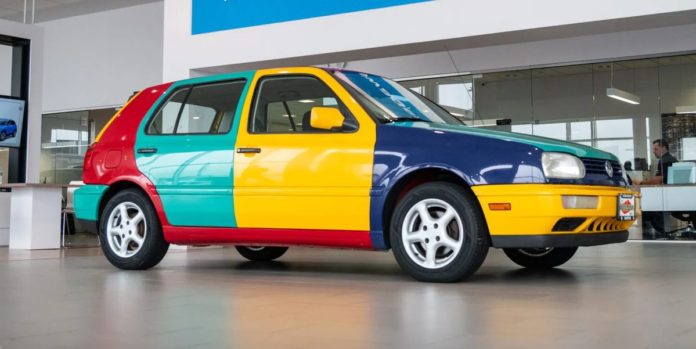- A riff on the European Polo Harlequin, the Volkswagen Golf Harlequin mixed and matched panels in four colors: Chagall Blue, Ginster Yellow, Tornado Red, and Pistachio Green.
- While the Polo Harlequin was very popular, the U.S.-only Golf version was a dud. Just 264 were made, and some were soon converted to single colors.
- New-car buyers shunned it, but the Golf Harlequin is fun, easy to live with, and one of the most coveted collectible water-cooled Volkswagens today, and this one is up for auction until April 9.
It was certainly the most colorful, and unusual, special edition most Americans had ever seen in 1996. But Volkswagen had every reason to think the Golf Harlequin could succeed. A North American riff on the European Mk 3 Polo Harlekin, it offered the same multicolor body panels and natty interior as that very popular car. But like Modern Talking or Robbie Williams, this well-liked Euro act just didn’t translate stateside. Looking at the seemingly mismatched panels, Americans gave the Harlequin a collective “Vas ist das?” and ignored it.
Today, the Golf Harlequin’s bold, cheerful style is much more appreciated, and Volkswagen diehards even make Harlequin tributes out of modern VWs. This Harlequin, up for auction on Bring a Trailer (which, like Car and Driver, is part of Hearst Autos) and one of just 264 made, is a clean, well-equipped example of what has since become one of the most coveted 1990s VWs.
Although Volkswagen featured a similar multiply hued Beetle in one of its famous 1960s Doyle Dane Bernbach ads, the Golf Harlequin and Polo Harlekin (the German spelling) were the result of a later accident of creative inspiration. In the summer of 1994, Wolfsburg created an initial batch of multicolor Polos to demonstrate the then-new Mk 3’s production techniques and customization choices. These cars were meant for brochures and dealer demonstrations, but consumers immediately started asking where they could buy one.
At the time limited-run specials, created with decals, fabrics, and paint, were big business in Europe, especially among Polo’s supermini rivals like the Citroën Saxo and Ford Fiesta. With buyers actively approaching the company, Volkswagen decided to build 1000 of them, naming the car “Harlekin” and giving it special “Joker” plaid interior fabrics. Demand was so strong that a second run of 2800 cars followed.
This success inspired Volkswagen of America to create four similar Golfs to test at auto shows in late 1995. Reaction was positive enough to justify a small run of ’96 models at the company’s Puebla, Mexico, plant. Like the Polo, the Golf Harlequin used the Joker fabric and four mixed colors (Chagall Blue, Ginster Yellow, Tornado Red, and Pistachio Green) in four specific patterns. The design was absolutely not haphazard, but that’s not what buyers thought.
Americans knew nothing about European special editions (which included Bon Jovi– and Pink Floyd–branded Golfs) or the Polo Harlekin. To many people, the car sort of looked like your high school buddy’s 1972 Gremlin, with junkyard-salvaged multicolored fenders and doors. It was just too conspicuously weird for Americans.
A few buyers loved them, but most took ages to sell, and the model was quietly dropped by the fall. One dealer, Atlanta’s Jim Ellis Volkswagen, received some unwanted Harlequins used during the 1996 Olympics. To unload them, they reassembled a few as solid-color cars.
But while buyers shunned the Golf Harlequin then, over time its jaunty, high-fashion looks have come to be more appreciated. It’s a cult car within a cult brand, so there are registries and owners’ groups that closely track the whereabouts of Golf Harlequins, and they are considerably more valuable than other Mk 3 Golfs, including VR6-powered GTIs.
Hardcore VW fans still like the idea, as evidenced by how upset they were online this past week when Volkswagen UK teased an ID.3 Harlequin only for it to prove an April Fools’ Day joke. But while it’s unlikely that VW will ever sell another Harlequin in America, much less an ID.3, you can saddle up with this well-kept example with just under 79,000 miles on the clock.
Apart from the cosmetic elements, the Harlequin was a bog-standard base-model Golf GL. All were powered by a 115-hp 2.0-liter 115-hp four driving the front wheels via a five-speed manual or optional four-speed automatic. Since Golf fans are a performance subculture, many Harlequins have been modified with engines like the VR6 and lots of suspension and wheel changes. For some owners, however, originality is paramount given this car’s rarity.
Either way, the Harlequin Golf’s livability-to-rarity ratio is spectacular. Apart from the cosmetic pieces, parts and service are a breeze, and while the “2.slow” isn’t very exciting, it’s reliable and gets good gas mileage. Plus, the Mk 3 Golf is a fun handler no matter the engine, and this one does have a few options, such as a cassette player and A/C. What people will notice, however, is the color scheme, and Harlequin owners are barraged with questions almost everywhere they go.
If you want to be the center of attention and have something truly rare, you have until April 9 to put in a bid.




